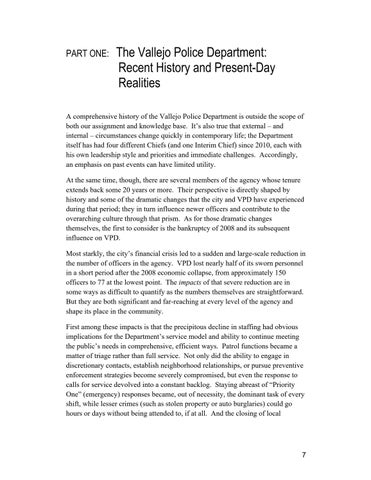PART ONE:
The Vallejo Police Department: Recent History and Present-Day Realities
A comprehensive history of the Vallejo Police Department is outside the scope of both our assignment and knowledge base. It’s also true that external – and internal – circumstances change quickly in contemporary life; the Department itself has had four different Chiefs (and one Interim Chief) since 2010, each with his own leadership style and priorities and immediate challenges. Accordingly, an emphasis on past events can have limited utility. At the same time, though, there are several members of the agency whose tenure extends back some 20 years or more. Their perspective is directly shaped by history and some of the dramatic changes that the city and VPD have experienced during that period; they in turn influence newer officers and contribute to the overarching culture through that prism. As for those dramatic changes themselves, the first to consider is the bankruptcy of 2008 and its subsequent influence on VPD. Most starkly, the city’s financial crisis led to a sudden and large-scale reduction in the number of officers in the agency. VPD lost nearly half of its sworn personnel in a short period after the 2008 economic collapse, from approximately 150 officers to 77 at the lowest point. The impacts of that severe reduction are in some ways as difficult to quantify as the numbers themselves are straightforward. But they are both significant and far-reaching at every level of the agency and shape its place in the community. First among these impacts is that the precipitous decline in staffing had obvious implications for the Department’s service model and ability to continue meeting the public’s needs in comprehensive, efficient ways. Patrol functions became a matter of triage rather than full service. Not only did the ability to engage in discretionary contacts, establish neighborhood relationships, or pursue preventive enforcement strategies become severely compromised, but even the response to calls for service devolved into a constant backlog. Staying abreast of “Priority One” (emergency) responses became, out of necessity, the dominant task of every shift, while lesser crimes (such as stolen property or auto burglaries) could go hours or days without being attended to, if at all. And the closing of local
7

